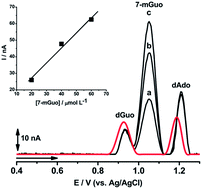Electrochemical detection of 7-methylguanosine and DNA-methylation
Abstract
DNA damage has been associated with cancer. Alkylating agents interact with DNA to yield a variety of products, such as 7-methylguanosine (7-mGuo), a predominant adduct, 5-methylcytosine, 3-methyladenosine and o-6-methylguanosine. This work revealed, for the first time, the oxidation mechanism of 7-mGuo on a glassy carbon electrode (GCE) using cyclic and differential pulse voltammetry, as well as impedance spectroscopy. 7-mGuo is irreversibly oxidized in a pH dependent single step reaction, predominantly under diffusion control. The anodic behaviour of 7-mGuo was compared with the anodic behaviour of other guanine derivatives. An electroanalytical method was proposed for the determination of 7-mGuo using a GCE by differential pulse voltammetry at physiological pH, with a limit of detection of 3.26 μmol L−1 and a limit of quantification of 10.88 μmol L−1. The electrochemical detection of 7-mGuo was also investigated in the presence of the potential interferents guanine, guanosine and 7-methylguanine (7-mGua). The study demonstrated that the anodic peak of 7-mGuo did not suffer from any interference from these species, since its oxidation happens at a very distinct potential. A differential pulse voltammetry study of 7-mGua and 7-mGuo in the presence of double-helix DNA (dsDNA) or DNA bases was carried out aiming to investigate the possibility of using a DNA-electrochemical biosensor for detection of DNA methylation. The electrochemical data revealed that the DNA methylation damage can be detected by a distinct signal and quantified using a DNA biosensor.



 Please wait while we load your content...
Please wait while we load your content...